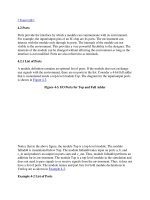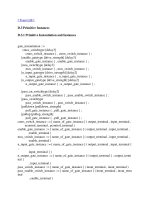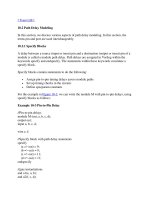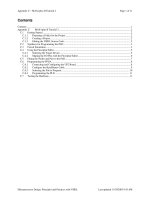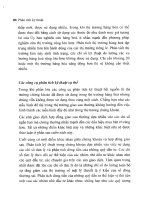Charting Made Easy Part 2 ppt
Bạn đang xem bản rút gọn của tài liệu. Xem và tải ngay bản đầy đủ của tài liệu tại đây (152.37 KB, 16 trang )
Charting Made Easy 9
Chapter 4
SUPPORT AND RESISTANCE
TRENDLINES AND CHANNELS
T
here are two terms that define the peaks and troughs
on the chart.A previous trough usually forms a support
level. Support is a level below the market where buy-
ing pressure exceeds selling pressure and a decline is halted.
Resistance is marked by a previous market peak. Resistance is a
level above the market where selling pressure exceeds buying
pressure and a rally is halted (See Figure 4-1).
Support and resistance levels reverse roles once they are
decisively broken. That is to say, a broken support level under
the market becomes a resistance level above the market. A
broken resistance level over the market functions as support
below the market.The more recently the support or resistance
level has been formed, the more power it exerts on subsequent
market action.This is because many of the trades that helped
form those support and resistance levels have not been liqui-
dated and are more likely to influence future trading decisions
(See Figure 4-2).
The trendline is perhaps the simplest and most valuable tool
available to the chartist.An up trendline is a straight line drawn
up and to the right, connecting successive rising market bot-
toms.The line is drawn in such a way that all of the price action
10 Trade Secrets
Figure 4-2. ROLE REVERSAL Sun Microsystems (SUNW)
An example of role reversal. A broken resistance level usually becomes a new sup-
port level. In a downtrend, a broken support level becomes resistance.
Prior resistance
level . . .
. . . becomes new support level
Figure 4-1 SUPPORT AND RESISTANCE Sun Microsystems (SUNW)
An uptrend is marked by rising peaks and troughs. Each peak is called resistance;
each trough is called support. The uptrend is continued when a resistance peak is
exceeded.
Resistance
Support
Support
Resistance
Charts powered by MetaStock
Charts powered by MetaStock
Figure 4-3. RISING TRENDLINE Sun Microsystems (SUNW)
An example of a rising trendline. Up trendlines are drawn under rising lows. A valid
trendline should be touched three times as shown here.
Charting Made Easy 11
is above the trendline.A down trendline is drawn down and
to the right, connecting the successive declining market highs.
The line is drawn in such a way that all of the price action is
below the trendline. An up trendline, for example, is drawn
when at least two rising reaction lows (or troughs) are visible.
However, while it takes two points to draw a trendline, a third
point is necessary to identify the line as a valid trend line. If
prices in an uptrend dip back down to the trendline a third
time and bounce off it, a valid up trendline is confirmed (See
Figure 4-3).
Trendlines have two major uses.They allow identification of
support and resistance levels that can be used, while a market
is trending, to initiate new positions. As a rule, the longer a
trendline has been in effect and the more times it has been test-
ed, the more significant it becomes.The violation of a trendline
is often the best warning of a change in trend.
Up trendlines drawn
under rising lows
1
2
3
Charts powered by MetaStock
12 Trade Secrets
Channel lines are straight lines that are drawn parallel to
basic trendlines. A rising channel line would be drawn above
the price action and parallel to the basic trendline (which is
below the price action). A declining channel line would be
drawn below the price action and parallel to the down trend-
line (which is above the price action). Markets often trend with-
in these channels.When this is the case,the chartist can use that
knowledge to great advantage by knowing in advance where
support and resistance are likely to function (See Figure 4-4).
Figure 4-4. CHANNEL LINE Sun Microsystems (SUNW)
An example of a channel line. During an uptrend, prices will often meet new selling
along an upper channel line which is drawn parallel to the rising trendline.
Rising trendline
Channel line
Charts powered by MetaStock
REVERSAL AND
CONTINUATION PRICE
PATTERNS
O
ne of the more useful features of chart analysis is the
presence of price patterns, which can be classified
into different categories and which have predictive
value.These patterns reveal the ongoing struggle between the
forces of supply and demand, as seen in the relationship
between the various support and resistance levels, and allow
the chart reader to gauge which side is winning.Price patterns
are broken down into two groups — reversal and continuation
patterns. Reversal patterns usually indicate that a trend rever-
sal is taking place. Continuation patterns usually represent
temporary pauses in the existing trend.Continuation patterns
take less time to form than reversal patterns and usually
result in resumption of the original trend.
REVERSAL PATTERNS
The Head and Shoulders
The head and shoulders is the best known and probably the
most reliable of the reversal patterns.A head and shoulders top
is characterized by three prominent market peaks.The middle
Chapter 5
Charting Made Easy 13
Figure 5-1. HEAD AND SHOULDERS America Online (AOL)
Example of a head and shoulders bottom on a daily chart of America Online (AOL).
14 Trade Secrets
peak, or the head, is higher than the two surrounding peaks
(the shoulders). A trendline (the neckline) is drawn below the
two intervening reaction lows.A close below the neckline com-
pletes the pattern and signals an important market reversal (See
Figure 5-1).
Price objectives or targets can be determined by measuring the
shapes of the various price patterns.The measuring technique in
a topping pattern is to measure the vertical distance from the top
of the head to the neckline and to project the distance down-
ward from the point where the neckline is broken.The head and
shoulders bottom is the same as the top except that it is turned
upside down.
Double and Triple Tops and Bottoms
Another one of the reversal patterns, the triple top or bottom,
is a variation of the head and shoulders.The only difference is
Neckline
Head
Right shoulderLeft shoulder
Charts powered by MetaStock
that the three peaks or troughs in this pattern occur at about the
same level. Triple tops or bottoms and the head and shoulders
reversal pattern are interpreted in similar fashion and mean
essentially the same thing.
Double tops and bottoms (also called M’s and W’s because
of their shape) show two prominent peaks or troughs instead
of three.A double top is identified by two prominent peaks.
The inability of the second peak to move above the first peak
is the first sign of weakness. When prices then decline and
move under the middle trough, the double top is completed.
The measuring technique for the double top is also based on
the height of the pattern. The height of the pattern is mea-
sured and projected downward from the point where the
trough is broken. The double bottom is the mirror image of
the top (See Figures 5-2 and 5-3).
Figure 5-2. DOUBLE BOTTOM General Electric (GE)
Example of a double bottom on the daily chart of General Electric (GE).
Charting Made Easy 15
12
Charts powered by MetaStock
16 Trade Secrets
Saucers and Spikes
These two patterns aren’t as common, but are seen enough
to warrant discussion.The spike top (also called a V-reversal)
pictures a sudden change in trend. What distinguishes the
spike from the other reversal patterns is the absence of a tran-
sition period, which is sideways price action on the chart con-
stituting topping or bottoming activity. This type of pattern
marks a dramatic change in trend with little or no warning
(See Figure 5-4).
The saucer, by contrast, reveals an unusually slow shift in
trend.Most often seen at bottoms,the saucer pattern represents
a slow and more gradual change in trend from down to up.The
chart picture resembles a saucer or rounding bottom — hence
its name (See Figure 5-5).
Figure 5-3. DOUBLE TOP REVERSAL PATTERN IBM
Two prominent peaks can be seen on the chart of IBM, forming a double top reversal
pattern.
1
2
Charts powered by MetaStock
Figure 5-5. SAUCER BOTTOM Advanced Micro Devices (AMD)
Some bottoms are a slow, gradual process and have a rounding shape like a saucer.
This saucer bottom in Advanced Micro Devices (AMD) took almost a year to form.
Charting Made Easy 17
Saucer Bottom
Figure 5-4. SPIKE TOPS AND BOTTOMS Lucent Technologies (LU)
Two examples of a stock changing direction with little or no warning.
Spike Top
Spike Bottom
Charts powered by MetaStock
Charts powered by MetaStock
18 Trade Secrets
CONTINUATION PATTERNS
Triangles
Instead of warning of market reversals, continuation patterns
are usually resolved in the direction of the original trend. Tri-
angles are among the most reliable of the continuation pat-
terns. There are three types of triangles that have forecasting
value —symmetrical, ascending and descending triangles.
Although these patterns sometimes mark price reversals, they
usually just represent pauses in the prevailing trend.
The symmetrical triangle (also called the coil) is distinguished
by sideways activity with prices fluctuating between two con-
verging trendlines.The upper line is declining and the lower line
is rising. Such a pattern describes a situation where buying and
selling pressure are in balance. Somewhere between the half-
Figure 5-6. SYMMETRICAL TRIANGLE Citigroup (C)
An example of a symmetrical triangle during the 1999 advance in Citigroup. The two
lines converge, with the upper line falling and the lower line rising. Since this is a
continuation pattern, the odds favored resumption of the bull trend.
Rising lower line
Declining upper line
Charts powered by MetaStock
Figure 5-7. ASCENDING TRIANGLE AG Edwards (AGE)
way and the three-quarters point in the pattern, measured in
calendar time from the left of the pattern to the point where
the two lines meet at the right (the apex), the pattern should
be resolved by a breakout. In other words, prices will close
beyond one of the two converging trendlines (See Figure 5-6).
The ascending triangle has a flat upper line and a rising
lower line. Since buyers are more aggressive than sellers, this is
usually a bullish pattern (See Figure 5-7).
The descending triangle has a declining upper line and a flat
lower line. Since sellers are more aggressive than buyers, this is
usually a bearish pattern.
The measuring technique for all three triangles is the same.
Measure the height of the triangle at the widest point to the left
of the pattern and measure that vertical distance from the point
Charting Made Easy 19
Flat upper line
Rising lower line
An example of an ascending triangle. The upper line is flat, while the lower line is
rising. This is usually a bullish pattern and is completed when prices close above the
upper line.
Charts powered by MetaStock
Figure 5-8. PENNANT Apple Computer (AAPL)
An example of a pennant forming during the ascent of Apple Computer during
November 1999. The pennant looks like a small symmetrical triangle, but normally
doesn’t last for more than two or three weeks. The breaking of the upper line signals
resumption of the uptrend.
20 Trade Secrets
where either trendline is broken. While the ascending and de-
scending triangles have a built-in bias,the symmetrical triangle is
inherently neutral. Since it is usually a continuation pattern, how-
ever, the symmetrical triangle does have forecasting value and
implies that the prior trend will be resumed.
Flags and Pennants
These two short-term continuation patterns mark brief paus-
es, or resting periods, during dynamic market trends. Both are
usually preceded by a steep price move (called the pole). In an
uptrend, the steep advance pauses to catch its breath and
moves sideways for two or three weeks.Then the uptrend con-
tinues on its way.The names aptly describe their appearance.
The pennant is usually horizontal with two converging trend-
Bullish pennant
Charts powered by MetaStock
Figure 5-9. FLAG Seagate Technology (SEG)
An example of a bullish flag forming during November 1999 about midway through
the rally in Seagate Technology. Bull flags are short-term patterns that slope against
the prevailing trend. The uptrend usually resumes after the upper line is broken.
Charting Made Easy 21
Bull flag
lines (like a small symmetrical triangle). The flag resembles a
parallelogram that tends to slope against the trend. In an
uptrend, therefore, the bull flag has a downward slope; in a
downtrend, the bear flag slopes upward. Both patterns are said
to “fly at half mast,”meaning that they often occur near the mid-
dle of the trend, marking the halfway point in the market move
(See Figures 5-8 and 5-9).
In addition to price patterns, there are several other forma-
tions that show up on the price charts and that provide the
chartist with valuable insights. Among those formations are
price gaps, key reversal days, and percentage retracements.
Charts powered by MetaStock
PRICE GAPS
G
aps are simply areas on the bar chart where no trad-
ing has taken place.An upward gap occurs when the
lowest price for one day is higher than the highest
price of the preceding day. A downward gap means that the
highest price for one day is lower than the lowest price of the
preceding day.There are different types of gaps that appear at
different stages of the trend. Being able to distinguish among
them can provide useful and profitable market insights.Three
types of gaps have forecasting value — breakaway,runaway and
exhaustion gaps (See Figure 6-1).
The breakaway gap usually occurs upon completion of an
important price pattern and signals a significant market move.
A breakout above the neckline of a head and shoulders bottom,
for example, often occurs on a breakaway gap.
The runaway gap usually occurs after the trend is well
underway. It often appears about halfway through the move
(which is why it is also called a measuring gap since it gives
some indication of how much of the move is left.) During
uptrends,the breakaway and runaway gaps usually provide sup-
port below the market on subsequent market dips; during
downtrends, these two gaps act as resistance over the market
on bounces.
Chapter 6
Charting Made Easy 23
Figure 6-1. PRICE GAPS Lucent Technologies (LU)
Examples of price gaps. The two gaps along the bottom formed an island reversal in
October 1999 in Lucent. There’s also a measuring gap halfway through the rally and
an exhaustion gap near the final top.
24 Trade Secrets
The exhaustion gap occurs right at the end of the market
move and represents a last gasp in the trend. Sometimes an
exhaustion gap is followed within a few days by a breakaway
gap in the other direction, leaving several days of price action
isolated by two gaps. This market phenomenon is called the
island reversal and usually signals an important market turn.
Exhaustion gap
Downside
exhaustion gap
Measuring or
halfway gap
Upside
breakway gap
Island Reversal Bottom
Charts powered by MetaStock




